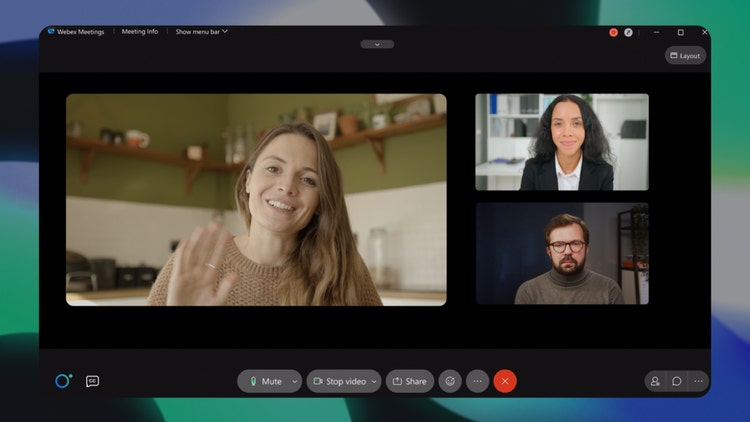Cisco Collaboration EVP Jeetu Patel: ‘We’re The Farthest Along In This Space By A Mile’
‘We feel like that’s why customers come to us. We understand the network, we understand how packets flow through the network, we understand how that can get more optimized. We understand how people can have a delightful experience and not have to worry about bad internet connectivity, high packet loss … all of those kinds of problems disappear,’ says Cisco EVP and GM Jeetu Patel.

Cisco Systems’ Webex platform, a market leader in the collaboration space, has been infused with AI in ways that the company says makes the platform smarter and more intuitive – not to mention more effective thanks to technology that can identify and remedy unstable video connections and choppy audio.
The tech giant last week at its WebexOne 2023 event unveiled a smattering of new Webex devices, features and upgrades. Included was new Real-Time Media Models (RMM) designed to pick up on visual and audible cues, such as gestures, or an individual walking out of the room during a meeting. The job of the AI-based RMMs is to enhance audio and video quality by using these actions and object recognition as context. Cisco’s new AI Codec in Webex, also based on generative AI technology, works to solve the challenge of audio quality, regardless of network conditions, by allowing for transmission redundancy to recover from network packet loss. Cisco’s Webex AI Assistant also now includes a new set of features that pull in RMM and Large Language Models (LLMs) to improve communication and collaboration for both hybrid workers and contact center agents. And that’s just to name a few of the innovations that were showcased.
The main takeaway for partners is that the Webex platform, unlike many competing collaboration platforms on the market, is leveraging the strength the tech giant has in networking, security and observability. It’s giving Webex differentiation in the crowded market, said Jeetu Patel, Cisco’s executive vice president and general manager of security and collaboration.
But speaking of the competition, Cisco knows that customers have made investments in third-party platforms. In this new wave of collaboration buying that’s coming on the heels of three-year technology refresh cycles, the company would rather partner with a competitor – something that Cisco is already doing by pairing its hardware with Microsoft Teams environments.
Patel sat down with CRN to talk about Cisco Collaboration’s AI strategy, working with the competition, and how the tech giant’s networking and security expertise are being applied to the Webex platform.
Here are excerpts from the conversation.

How is Cisco using AI to transform the Webex Platform?
We have completely reimagined the platform with AI at the core of it. There’s an AI fabric that’s going to be powering the platform and it is the most comprehensive AI-powered platform for collaboration in the market. It’s does great on language intelligence, great on audio intelligence, on video intelligence, and ties it all together so that the richness and context and the ability to augment signals from text and non-text coming together very fluidly is going to be super powerful. So that’s one -- one consistent AI system that everyone gets, no matter what product they use. Number two, we’ve solved some really hard computer science problems with things like AI Codec, things like Super Resolution video, things like real-time media models, which are truly industry leading and no one else is doing this right now. We’re the farthest along in this space by a mile and that’s super exciting to see. I think it goes down to focus. We are very focused in Webex on doing a few things really, really well. I’m not just joking when I say: “Well, we aren’t building the next word processor because that’s not what we want to do.” We are going to take the engineering resources we have and do something that we’re really good at doing and make [the Webex platform] the world’s best by an order of magnitude. We feel like that’s why customers come to us. We understand the network, we understand how packets flow through the network, we understand how that can get more optimized. We understand how people can have a delightful experience and not have to worry about bad internet connectivity and high packet loss. Or “I’ve got a bad connection. I can’t really hear you. I can’t see you. Can you repeat yourself?” Again, all of those kinds of problems disappear.
The biggest thing I want people to take away is that we have built a very durable, scalable, highly functional, AI-powered platform that all our applications sit on top of. So, every persona that uses applications that sit on the platform will benefit from AI. The end user benefits, the agent, the supervisors who might use our contact center app, the IT administrators benefit.

How does Cisco’s networking expertise help Cisco Webex stand apart in the collaboration space?
Think about it: networking, security, collaboration, and observability, all of these things start to come together. Those are the four businesses we’re in and each business makes the other business better. That’s the beauty of the flywheel effect that you get with Cisco. Our networking business makes our application business better, our application business makes our infrastructure business better and it just keeps feeding each other. Then over time, that’s all going to get even better with Splunk.
The way in which we’ve kind of curated the capability with the unique set of data that we have is what really differentiates us because no one else can do the ThousandEyes integration deeply into Control Hub so that with natural language, you can say: “Why is my connection bad?” And it tells you exactly why in a graphic when you’ve asked the question in natural language. And we’ve actually done a lot to make sure that your connection never gets bad because we’ve got a new codec. So, the kind of attention to detail on this stuff, hopefully sends a signal that this is the most powerful platform in this industry for the use cases we serve.
How is Cisco thinking about taking more share in the crowded collaboration space?
The way to think about this is not in zero sum. This is really important. If people use Microsoft Teams, Cisco will make money because we will have our devices that can actually be supporting the Teams implementations that organizations have. The reason we did that is whenever there’s something that has a tailwind, we don’t want to fight it, we want to enable it. We’re going to make sure that we build technology to go out and help organizations use that technology more effectively. Microsoft Teams actually gets better when it’s used with Cisco devices because they get benefit of our AI capabilities. So, if people use Microsoft Teams, use us with Cisco.

How is Cisco working to grow the collaboration business and what’s the role partners can play in accelerating Webex?
Last quarter we actually grew 11 percent in bookings, so, we’re actually seeing a return to growth of the business. Because our business is so large, so much of it is on-prem and the revenue numbers can be misleading. Sometimes, revenue goes down, even though the cloud business is growing. But our suite business is growing at high double-digits. Our contact center business last quarter grew by triple-digits, our Calling business is doing high double-digit growth, so we’re actually seeing a fair amount of growth in the businesses that we have. The portfolio is in the best shape that it’s ever been in and there’s more optimism right now in the executive team at Cisco than there ever has been about this business.
We are a partner-centric company, everything we do is partner-first. In fact, if you talk to partners, the excitement and enthusiasm that they have about our products right now has gone up exponentially compared to three years ago when I joined. Our NPS score says it all -- we were in the low 20s. Now, we’re in the mid 60s. That’s actually great. But I would say that the reason partners are excited is because we are supporting an open ecosystem, rather than an all or nothing kind of approach that a lot of companies have. The way we think about it is even if you happen to be a competitor, we will work with you. Because if we start from the customer and work backwards, customers will have made investments in multiple different platforms, and we want to make sure that we can protect the investments regardless of platform. As long as Cisco is one of those platforms, we will play a role in protecting their investment. And I think it’s unique; I don’t think everyone operates that way. We’ve been saying this for three years and we are showing you products and integrations and technology partnerships with some of our biggest competitors because we actually feel like it’s better for the customer and it’s the same thing in security. The true enemy is the adversary, not the competitor. So, we’d rather partner up with a competitor so that we can actually go out and beat the bad guys.

Cisco has announced 10 acquisitions so far this year. What’s your strategy in the collaboration space and are you open to growth via acquisition?
The way I think about acquisitions is that companies that are great tech companies, the one thing that they master is how to build great products. Now, if you have a very clear view of the strategy you’re pursuing and if someone else could help you accelerate that strategy, and you can acquire them, that’s great, we wouldn’t be shy to acquire as you’ve seen with us in the recent past. We’ve made six acquisitions in collaboration [since 2020]. So, we’re not afraid to acquire. But acquisition is not the strategy. Building great products and experiences for our customers is, and if a company helps us accelerate that and they’re a good cultural fit, and they’re available at a reasonable price, we won’t be shy to acquire. But it needs to meet those three conditions.